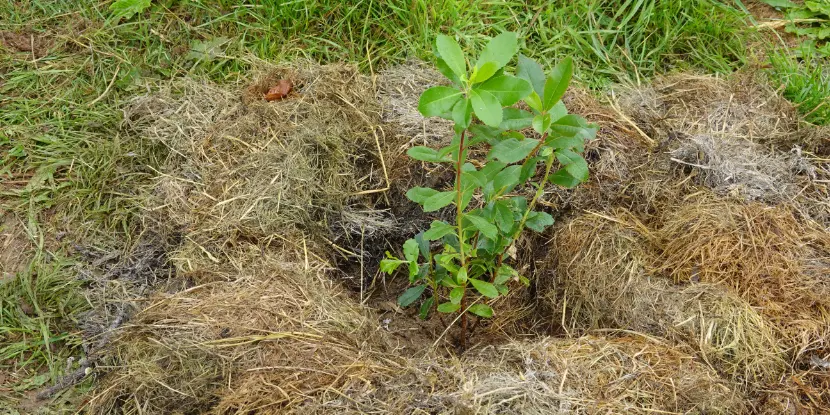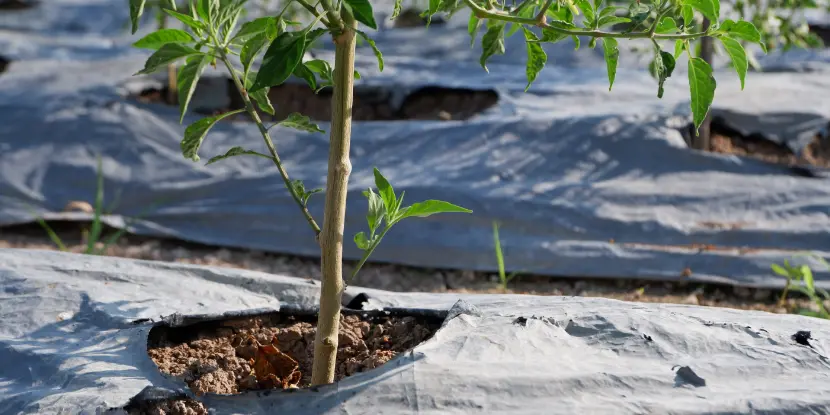One of gardening’s oldest techniques is also one of the cheapest and most effective. And it’s especially useful in dry climates like Southern California’s.
We’re talking about mulching or covering the soil with a protective layer. What makes it so special, almost indispensable in arid regions?
Mulching: A Brief History
Mulching in agriculture dates back to Ancient Egypt, when the Egyptians used straw mulch to protect plants from the harsh desert sun.
In other regions, the practice of mulching predates written gardening records.
In the 17th and 18th centuries, European gardeners applied straw and wood chips to improve soil conditions and suppress weeds. These early methods laid the foundation for modern mulching practices, which now incorporate a variety of organic and synthetic materials.
Today, mulching is an essential component of sustainable farming practices worldwide.

Straw was the first mulching material ever used. It’s still going strong today!
Mulching Benefits
1. Moisture Retention
- Mulch acts like a sponge, absorbing water and slowly releasing it into the soil.
- This means less frequent watering, saving time and reducing water bills.
- Mulching is crucial in dry areas or during hot summer months.
2. Weed Suppression
- A thick layer of mulch blocks sunlight, preventing weed seeds from germinating.
- This means fewer weeds competing with your plants for nutrients and water.
- Less weeding translates to more time enjoying your garden!

Commercial growers prefer plastic mulch.
3. Soil Temperature Regulation
- Mulch insulates against extreme heat and cold, keeping soil temperatures stable.
- It protects plant roots from temperature fluctuations, promoting healthier growth.
4. Soil Health Improvement
- Organic mulches decompose over time, adding nutrients to the soil.
- It improves soil structure, aeration, and fertility.
- It encourages beneficial microbial activity.
5. Erosion Control
- Mulch reduces the impact of rain and wind and, therefore, soil erosion.
- It keeps topsoil where it belongs – in your garden.
6. Aesthetic Appeal
- Mulch provides a neat, finished look to garden beds.
- It’s available in various colors, materials, and textures to suit your garden style.

Wood bark is one of the most popular and attractive types of mulch.
Types of Mulch
Organic Mulches
Organic mulches are derived from natural materials and decompose over time, enriching the soil. Popular choices include:
- Wood Chips and Bark: Long-lasting and attractive; great for flower beds and around trees.
- Straw & Hay: Excellent for vegetable gardens; adds organic matter.
- Grass Clippings: Readily available and free. Best used in thin layers to avoid matting.
- Compost: Provides a nutrient-rich layer. Ideal for all garden types.
- Leaves: Shred before use to prevent matting and improve decomposition.
Inorganic Mulches
Inorganic mulches don’t decompose and provide long-lasting weed suppression. Common types include:
- Gravel and Stone: Durable and decorative. Suitable for pathways and xeriscaping.
- Landscape Fabric: An effective weed barrier; often used under other mulches for added protection.
- Plastic Mulch: Excellent for moisture retention and weed control. Commonly used in commercial agriculture.
How to Mulch: Tips & Techniques
Here are some practical tips and techniques to get the most out of your mulch.
Preparation
- Weed First: Remove existing weeds before applying mulch to prevent them from poking through.
- Water Thoroughly: Water the soil deeply before mulching to ensure it’s well-hydrated.
- Choose the Right Mulch: Select a mulch that suits your garden’s needs and aesthetic.

Even rocks can be used as a form of mulching.
Application Techniques
- Layer It Up: Aim for a mulch layer 2–4 inches thick. Too thin, and it won’t be effective; too thick, and it may suffocate plants.
- Keep Away from Stems and Trunks: Leave a gap around plant stems and tree trunks to prevent rot and disease.
- Replenish as Needed: Organic mulches break down over time; replenish annually or as needed.
Common Mulching Mistakes to Avoid
- Over-mulching: Applying too much mulch can suffocate plants and harbor pests.
- Mulching against Tree Trunks: Piling mulch against tree trunks can lead to rot and disease. Always leave a gap.
- Ignoring Weeds: Applying mulch over weeds won’t stop them from growing. Always weed first.
- Using the Wrong Mulch: Choose a mulch that suits your needs and environment.
FAQs: More about Mulching Benefits
Q: Can I use mulch in my vegetable garden?
Mulch is fantastic for vegetable gardens. It helps retain moisture, suppresses weeds, and adds nutrients to the soil as it decomposes.
Q: How often should I replace my mulch?
Organic mulches should be replenished at least once a year or whenever they break down significantly. Inorganic mulches can last much longer but may need occasional tidying up.
Q: Is there such a thing as too much mulch?
Applying an overly thick layer of mulch can suffocate plants and create an environment for pests and disease. Stick to 2-4 inches for best results.
Q: What’s the best time of year to apply mulch?
Spring and fall are ideal times for mulching. In spring, mulch helps conserve moisture and suppress weeds. In fall, it provides insulation against winter’s chill.
Q: Can I use grass clippings as mulch?
Yes, but use them sparingly and ensure they’re dry. Fresh clippings can mat down, creating a barrier that water can’t penetrate, potentially leading to mold or rot.
Q: Can mulch attract pests?
Organic mulch can provide a moist environment that certain pests like to inhabit. Proper application and avoiding over-mulching can mitigate this risk.
Q: Can I mulch in the winter?
Yes, mulching in winter can protect plant roots from freezing temperatures and harsh winds. Apply a layer of mulch after the ground has frozen to help insulate your plants.
Q: Is mulch safe for all plants?
Most plants benefit from mulching, but choosing the right type and applying it correctly is critical. Some plants, especially those that prefer well-drained soil, might suffer if the mulch retains too much moisture.
Q: How does mulch impact soil pH?
Certain types of organic mulch, like pine needles, can slightly acidify the soil as they decompose. It’s important to monitor soil pH and adjust as needed, especially for plants with specific pH requirements.
Q: Can I mulch over perennial beds?
Yes, but apply mulch carefully to avoid covering the crowns of perennials.

